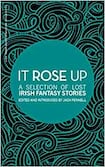
Fantasy writing occupies a comparatively lowly position in the modern literary hierarchy, the very term denoting, for naysayers, an escape from reality potentially bordering on the infantile, as though reality were somehow an incontestably preferable state to inhabit. After the 18 months we’ve just had, and with no end in sight, reality might understandably be viewed as somewhere interesting to visit but not necessarily to live permanently. After all, the realm of fantasy now includes a world without masks, so rarely has the value of escapism been made manifest to so many.
It Rose Up: A Selection of Lost Irish Fantasy Stories is a reminder of Irish literature’s long engagement with the business of imagining alternative realities, although it’s one that comes to something of a juddering halt early in the 20th century. The most recent of these tales dates from 1937, perhaps for copyright reasons, but pickings are also leaner in the decades that follow, as Irish genre writing becomes increasingly marginalised and devalued.
In his introduction to The Wild Night Company: Irish Stories of Fantasy and Horror, published in 1971, the prolific British editor Peter Haining complained of researching “in vain for stories among the present generation … [W]here have all the Irish storytellers gone that they remain unmoved by the romance around them?” The answer was that their homeland had little time for them, which makes the passion and commitment of later writers such as Mervyn Wall and Cathal Ó Sándair all the more commendable.
Broad remit
Fantasy is, of course, to some degree in the eye of the beholder. In his introduction, It Rose Up editor Jack Fennell distinguishes between high fantasy, which often features the wholesale reimagining of terrestrial history – George RR Martin’s A Song of Ice and Fire sequence, for example, the basis for Game of Thrones – and low fantasy, which tends to be subtler in its reconceptualising of our world. But the fantasy remit is also broad enough to accommodate horror, ghost stories and folk tales – although not science fiction, which has traditionally regarded itself as being not alone different from, but also superior to, fantasy.
George Egerton’s The Mandrake Venus, from 1898, probably skews closest to high fantasy here, with Charlotte McManus’s The Inhabitant in the Metal (1924) being incontestably low fantasy, so much so that the fantasy element is barely discernible.
Fennell largely eschews horror and ghosts in this anthology, 1890’s What Is a Ghoul? (anonymously published, but possibly the work of Lord Dunsany) and PJ O’Connor Duffy’s eerie Lanterns in the Twilight (1931) excepted. I suspect this may be because he has his sights set on similar future deep dives into those genres. I do hope so, because he and his publishers, Tramp Press, for whom It Rose Up is the seventh entry in their Recovered Voices series, are engaged in valuable work. Along with Swan River Press, they are reinstating neglected and excised writers to the canon of Irish literature, thereby also restoring much strangeness and colour, aided by Fennell’s facility with the Irish language, which has enabled him to include a number of writers originally published as Gaeilge.
Prescient stories
Some of the stories are amusingly prescient. In A Voyage to O’Brazeel, published in 1752, Manus O’Donnell describes a fantasy island on which “married couples were obliged by law … to yield their property to their children when those children turned thirty”, a move likely to prove so popular in the current climate that it’s a only a matter of time before it finds its way into an election manifesto. Hugh A MacCartan’s The Park-Keeper, from 1919, touches on the concept of parallel universes more than 30 years before Erwin Schrödinger’s pioneering lecture on the subject – a lecture given, incidentally, in Dublin, where Schrödinger had helped to establish the Institute for Advanced Studies, putting the fear of God into Irish cats in the process.
On the downside – and I concede that this is purely personal – a little of Dora Sigerson Shorter, a writer who rarely met an exclamation mark she didn’t like, goes a very long way, an excessive fondness for exclamation marks being, I feel, the sign of someone who could be rather hard going over the long stretch, both in person and in print. I counted 54 of them in her story Transmigration from 1900, although I concede I may have missed a few, having been rendered lightly stunned by their cumulative effect. It’s also possible that some readers may find one or two of the inclusions slightly esoteric. If I claimed to have understood what’s happening in Charlotte McManus’s The Vision of Aodh, AD 432, from 1901, I’d be lying, so I won’t for fear that something awful might befall me, in the manner of any number of unfortunates in this lovely, thoughtfully curated collection.
Shadow Voices: 300 Years of Irish Genre Fiction, A History in Stories, edited by John Connolly, has recently been published by Hodder & Stoughton











